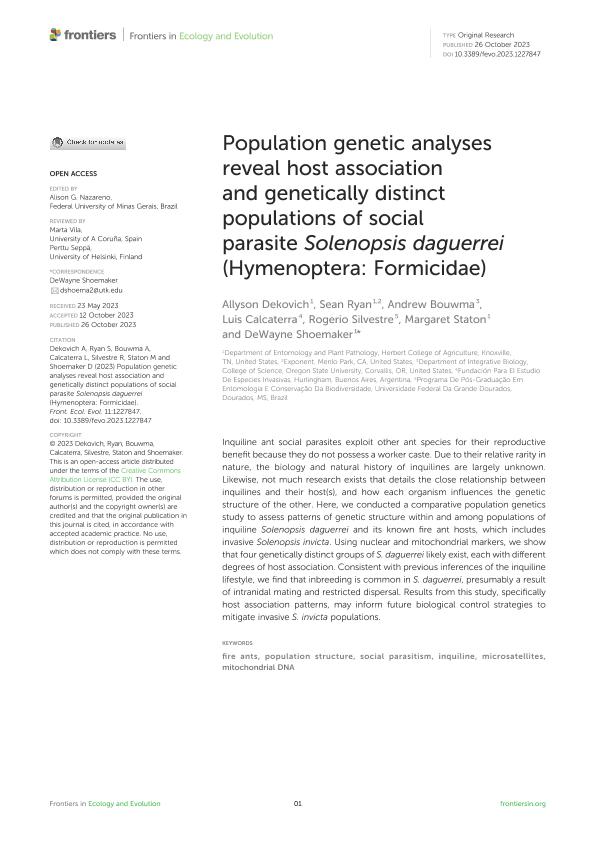Artículo
Population genetic analyses reveal host association and genetically distinct populations of social parasite Solenopsis daguerrei (Hymenoptera: Formicidae)
Dekovich, Allyson; Ryan, Sean; Bouwma, Andrew; Calcaterra, Luis Alberto ; Silvestre, Rogerio; Staton, Margaret; Shoemaker, DeWayne
; Silvestre, Rogerio; Staton, Margaret; Shoemaker, DeWayne
 ; Silvestre, Rogerio; Staton, Margaret; Shoemaker, DeWayne
; Silvestre, Rogerio; Staton, Margaret; Shoemaker, DeWayne
Fecha de publicación:
10/2023
Editorial:
Frontiers Media
Revista:
Frontiers in Ecology and Evolution
e-ISSN:
2296-701X
Idioma:
Inglés
Tipo de recurso:
Artículo publicado
Clasificación temática:
Resumen
Inquiline ant social parasites exploit other ant species for their reproductive benefit because they do not possess a worker caste. Due to their relative rarity in nature, the biology and natural history of inquilines are largely unknown. Likewise, not much research exists that details the close relationship between inquilines and their host(s), and how each organism influences the genetic structure of the other. Here, we conducted a comparative population genetics study to assess patterns of genetic structure within and among populations of inquiline Solenopsis daguerrei and its known fire ant hosts, which includes invasive Solenopsis invicta. Using nuclear and mitochondrial markers, we show that four genetically distinct groups of S. daguerrei likely exist, each with different degrees of host association. Consistent with previous inferences of the inquiline lifestyle, we find that inbreeding is common in S. daguerrei, presumably a result of intranidal mating and restricted dispersal. Results from this study, specifically host association patterns, may inform future biological control strategies to mitigate invasive S. invicta populations.
Archivos asociados
Licencia
Identificadores
Colecciones
Articulos(SEDE CENTRAL)
Articulos de SEDE CENTRAL
Articulos de SEDE CENTRAL
Citación
Dekovich, Allyson; Ryan, Sean; Bouwma, Andrew; Calcaterra, Luis Alberto; Silvestre, Rogerio; et al.; Population genetic analyses reveal host association and genetically distinct populations of social parasite Solenopsis daguerrei (Hymenoptera: Formicidae); Frontiers Media; Frontiers in Ecology and Evolution; 11; 10-2023; 1-17
Compartir
Altmétricas



